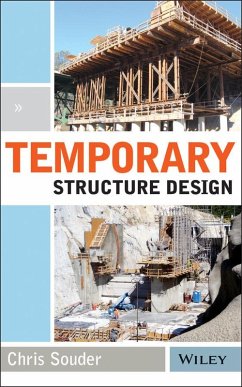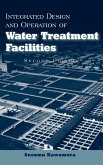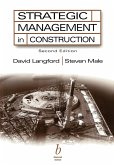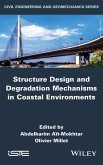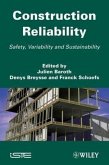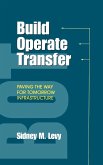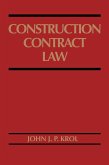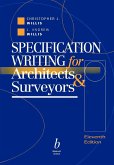Christopher Souder
Temporary Structure Design
Christopher Souder
Temporary Structure Design
- Gebundenes Buch
- Merkliste
- Auf die Merkliste
- Bewerten Bewerten
- Teilen
- Produkt teilen
- Produkterinnerung
- Produkterinnerung
WHEN SAFETY IS PARAMOUNT, PROPER DESIGN BECOMES CRITICAL As the first design-oriented guide to temporary construction structures, this book gives construction professionals and students alike a deeper understanding of the intricacies involved in scaffolding, formwork, shoring, and more. The safety of every worker on site depends upon the stability of these structures, which often must support tons of steel or concrete--and the most tragic failures are usually the result of improper design, construction, or maintenance. This detailed guide covers all aspects of temporary structure design, from…mehr
Andere Kunden interessierten sich auch für
![Integrated Design and Operation of Water Treatment Facilities Integrated Design and Operation of Water Treatment Facilities]() Susumu KawamuraIntegrated Design and Operation of Water Treatment Facilities207,99 €
Susumu KawamuraIntegrated Design and Operation of Water Treatment Facilities207,99 €![Strategic Management in Construction Strategic Management in Construction]() David LangfordStrategic Management in Construction113,99 €
David LangfordStrategic Management in Construction113,99 €![Structure Design and Degradation Mechanisms in Coastal Environments Structure Design and Degradation Mechanisms in Coastal Environments]() Structure Design and Degradation Mechanisms in Coastal Environments177,99 €
Structure Design and Degradation Mechanisms in Coastal Environments177,99 €![Construction Reliability Construction Reliability]() Construction Reliability166,99 €
Construction Reliability166,99 €![Build, Operate, Transfer Build, Operate, Transfer]() Sidney M LevyBuild, Operate, Transfer178,99 €
Sidney M LevyBuild, Operate, Transfer178,99 €![Construction Contract Law Construction Contract Law]() John J P KrolConstruction Contract Law189,99 €
John J P KrolConstruction Contract Law189,99 €![Specification Writing Specification Writing]() C J WillisSpecification Writing82,99 €
C J WillisSpecification Writing82,99 €-
-
-
WHEN SAFETY IS PARAMOUNT, PROPER DESIGN BECOMES CRITICAL As the first design-oriented guide to temporary construction structures, this book gives construction professionals and students alike a deeper understanding of the intricacies involved in scaffolding, formwork, shoring, and more. The safety of every worker on site depends upon the stability of these structures, which often must support tons of steel or concrete--and the most tragic failures are usually the result of improper design, construction, or maintenance. This detailed guide covers all aspects of temporary structure design, from loads, materials, equipment, procedures, and support types, to help ensure that these critical structures are safe and effective. * Review the basics of statics, measurement, and center of gravity * Review the strengths of common temporary structures materials and their allowable stresses * Design shoring, formwork, falsework, scaffold, bracing, and other support systems safely * Understand support system options, costs, and where each is applied When safety is at issue, there is no room for error. This book provides the information students and professionals need to make every structure sound and error-free.
Hinweis: Dieser Artikel kann nur an eine deutsche Lieferadresse ausgeliefert werden.
Hinweis: Dieser Artikel kann nur an eine deutsche Lieferadresse ausgeliefert werden.
Produktdetails
- Produktdetails
- Verlag: Wiley
- Seitenzahl: 448
- Erscheinungstermin: 1. November 2014
- Englisch
- Abmessung: 236mm x 157mm x 28mm
- Gewicht: 748g
- ISBN-13: 9781118905586
- ISBN-10: 111890558X
- Artikelnr.: 40549316
- Herstellerkennzeichnung
- Libri GmbH
- Europaallee 1
- 36244 Bad Hersfeld
- gpsr@libri.de
- Verlag: Wiley
- Seitenzahl: 448
- Erscheinungstermin: 1. November 2014
- Englisch
- Abmessung: 236mm x 157mm x 28mm
- Gewicht: 748g
- ISBN-13: 9781118905586
- ISBN-10: 111890558X
- Artikelnr.: 40549316
- Herstellerkennzeichnung
- Libri GmbH
- Europaallee 1
- 36244 Bad Hersfeld
- gpsr@libri.de
CHRIS SOUDER is an Associate Professor of Construction Management at the California State University in Chico, CA, focusing on Temporary Structures and Scheduling and Project Controls. He is a sixteen-year veteran of construction management in the heavy civil industry with Kiewit, taking various leading roles in high revenue projects.
About the Author xi
Preface xiii
Acknowledgments xv
1 Statics Review 1
1.1. Statics Review 1
1.2. Units of Measure 1
1.2.1. Common Units of Measure 2
1.3. Statics 3
1.3.1. Centroids/Center of Gravity 4
1.3.2. Properties of Sections 7
2 Strength of Materials Review 18
2.1. Stress 18
2.1.1. Normal Stress 18
2.1.2. Bending Stress 19
2.1.3. Shear Stress 19
2.1.4. Horizontal Shear Stress 20
2.1.5. Modulus of Elasticity 22
2.2. Bending Moments 22
2.2.1. Maximum Bending Moments 22
2.2.2. Maximum Shear 23
2.2.3. Law of Superposition 23
2.3. Materials 24
2.3.1. Factors of Safety 24
2.3.2. Grades of Steel 24
2.3.3. Compact Beam 25
2.3.4. Wood 26
2.4. Deflection 27
2.5. Shear and Moment Diagrams 28
2.6. Beam Design 34
2.6.1. Combined Stress 41
3 Types of Loads on Temporary Structures 45
3.1. Supports and Connections on Temporary Structures 45
3.1.1. Forces and Loads on Temporary Structures 47
3.1.2. Materials-How Different Materials Create Different Forces 48
4 Scaffolding Design 59
4.1. Regulatory 59
4.2. Types of Scaffolding 59
4.3. Loading on Scaffolding 61
4.4. Scaffolding Factors of Safety 62
4.5. Scaffold Components 62
4.5.1. Planking 62
4.5.2. Bearers (Lateral Supports) 62
4.5.3. Runners 62
4.5.4. Posts 63
4.5.5. OSHA 63
4.6. Scaffold Design 63
4.6.1. Securing Scaffolding to the Structure 69
4.6.2. Hanging Scaffold 69
5 Soil Properties and Soil Loading 75
5.1. Soil Properties 75
5.1.1. Standard Penetration Test and Log of Test Borings 77
5.1.2. Unit Weights above and below the Water Table 78
5.1.3. Testing 81
5.2. Soil Loading 81
5.2.1. Soil Mechanics 81
5.2.2. Active Soil Pressure and Coefficient 82
5.2.3. Soil Pressure Theories 83
5.2.4. Soil Pressure Examples Using Rankine Theory 85
5.2.5. Soil Pressures Using State and Federal Department Standards 91
6 Soldier Beam, Lagging, and Tiebacks 104
6.1. System Description and Units of Measure 104
6.1.1. Beams/Piles 104
6.1.2. Lagging 105
6.1.3. Tiebacks 105
6.2. Materials 105
6.2.1. Steel AISC 105
6.2.2. Wood Species-National Design Specifications (NDS) for Wood
Construction 106
6.2.3. Lagging 108
6.2.4. Soldier Beam Design 112
6.2.5. Tiebacks and Soil Nails 121
7 Sheet Piling and Strutting 130
7.1. Sheet Piling Basics 130
7.1.1. Materials 130
7.1.2. System Description and Unit of Measure 130
7.1.3. Driving Equipment 133
8 Pressure and Forces on Formwork and Falsework 155
8.1. Properties of Materials 155
8.1.1. Unit Weights 155
8.1.2. Forces from Concrete Placement 157
9 Concrete Formwork Design 178
9.1. General Requirements 178
9.1.1. Concrete Specifications 178
9.1.2. Types and Costs of Forms in Construction 179
9.2. Formwork Design 180
9.2.1. Bending, Shear, and Deflection 180
9.2.2. Form Design Examples Using All-Wood Materials with Snap Ties or Coil
Ties 191
9.2.3. Formwork Charts 199
9.2.4. Estimating Concrete Formwork 219
9.3. Conclusion 228
10 Falsework Design 229
10.1. Falsework Risks 229
10.1.1. Falsework Accidents 230
10.1.2. Falsework Review Process 233
10.1.3. Falsework Design Criteria 235
10.1.4. Load Paths for Falsework Design 236
10.1.5. Falsework Design Using Formwork Charts 242
10.1.6. Bridge Project 262
11 Bracing and Guying 267
11.1. Rebar Bracing and Guying 268
11.2. Form Bracing with Steel Pipe and Concrete Deadmen 269
11.2.1. Life Application of Friction Forces 278
11.3. Rebar Guying on Highway Projects 279
11.4. Alternate Anchor Method 289
12 Trestles and Equipment Bridges 300
12.1. Basic Composition of a Standard Trestle 300
12.1.1. Foundation-Pipe, H Pile, and Wide-Flange and Composite Piles 301
12.1.2. Cap Beams-Wide-Flange Beams with Stiffeners 301
12.1.3. Stringers/Girders-Wide-Flange Beams Braced Together 303
12.1.4. Lateral Bracing 303
12.1.5. Decking-Timber or Precast Concrete Panels 306
12.1.6. Environmental Concerns 308
12.1.7. Stringer Design 325
12.1.8. Star Pile Design and Properties 340
12.2. Other Projects Utilizing Methods of Access 341
12.3. Conclusion 343
13 Support of Existing Structures 344
13.1. Basic Building Materials 345
13.1.1. Example 13.1 Pipe Unit Weight 346
13.1.2. Example 13.2 Existing Water Treatment Plant 347
13.1.3. Example 13.3 Temporary Pipe Supports 354
Appendixes 369
Appendix 1: Steel Beams (AISC) 371
Appendix 2: Steel Pipe 391
Appendix 3: H Pile (AISC) 393
Appendix 4: Allowable Buckling Stress 395
Appendix 5: Sheet Pile (Skyline) 397
Appendix 6: Wood Properties 401
Appendix 7: Formwork Charts (Williams) 404
Appendix 8: Form Hardware Values (Williams) 412
Appendix 9: Aluminum Beams (Aluma) 422
Index 425
Preface xiii
Acknowledgments xv
1 Statics Review 1
1.1. Statics Review 1
1.2. Units of Measure 1
1.2.1. Common Units of Measure 2
1.3. Statics 3
1.3.1. Centroids/Center of Gravity 4
1.3.2. Properties of Sections 7
2 Strength of Materials Review 18
2.1. Stress 18
2.1.1. Normal Stress 18
2.1.2. Bending Stress 19
2.1.3. Shear Stress 19
2.1.4. Horizontal Shear Stress 20
2.1.5. Modulus of Elasticity 22
2.2. Bending Moments 22
2.2.1. Maximum Bending Moments 22
2.2.2. Maximum Shear 23
2.2.3. Law of Superposition 23
2.3. Materials 24
2.3.1. Factors of Safety 24
2.3.2. Grades of Steel 24
2.3.3. Compact Beam 25
2.3.4. Wood 26
2.4. Deflection 27
2.5. Shear and Moment Diagrams 28
2.6. Beam Design 34
2.6.1. Combined Stress 41
3 Types of Loads on Temporary Structures 45
3.1. Supports and Connections on Temporary Structures 45
3.1.1. Forces and Loads on Temporary Structures 47
3.1.2. Materials-How Different Materials Create Different Forces 48
4 Scaffolding Design 59
4.1. Regulatory 59
4.2. Types of Scaffolding 59
4.3. Loading on Scaffolding 61
4.4. Scaffolding Factors of Safety 62
4.5. Scaffold Components 62
4.5.1. Planking 62
4.5.2. Bearers (Lateral Supports) 62
4.5.3. Runners 62
4.5.4. Posts 63
4.5.5. OSHA 63
4.6. Scaffold Design 63
4.6.1. Securing Scaffolding to the Structure 69
4.6.2. Hanging Scaffold 69
5 Soil Properties and Soil Loading 75
5.1. Soil Properties 75
5.1.1. Standard Penetration Test and Log of Test Borings 77
5.1.2. Unit Weights above and below the Water Table 78
5.1.3. Testing 81
5.2. Soil Loading 81
5.2.1. Soil Mechanics 81
5.2.2. Active Soil Pressure and Coefficient 82
5.2.3. Soil Pressure Theories 83
5.2.4. Soil Pressure Examples Using Rankine Theory 85
5.2.5. Soil Pressures Using State and Federal Department Standards 91
6 Soldier Beam, Lagging, and Tiebacks 104
6.1. System Description and Units of Measure 104
6.1.1. Beams/Piles 104
6.1.2. Lagging 105
6.1.3. Tiebacks 105
6.2. Materials 105
6.2.1. Steel AISC 105
6.2.2. Wood Species-National Design Specifications (NDS) for Wood
Construction 106
6.2.3. Lagging 108
6.2.4. Soldier Beam Design 112
6.2.5. Tiebacks and Soil Nails 121
7 Sheet Piling and Strutting 130
7.1. Sheet Piling Basics 130
7.1.1. Materials 130
7.1.2. System Description and Unit of Measure 130
7.1.3. Driving Equipment 133
8 Pressure and Forces on Formwork and Falsework 155
8.1. Properties of Materials 155
8.1.1. Unit Weights 155
8.1.2. Forces from Concrete Placement 157
9 Concrete Formwork Design 178
9.1. General Requirements 178
9.1.1. Concrete Specifications 178
9.1.2. Types and Costs of Forms in Construction 179
9.2. Formwork Design 180
9.2.1. Bending, Shear, and Deflection 180
9.2.2. Form Design Examples Using All-Wood Materials with Snap Ties or Coil
Ties 191
9.2.3. Formwork Charts 199
9.2.4. Estimating Concrete Formwork 219
9.3. Conclusion 228
10 Falsework Design 229
10.1. Falsework Risks 229
10.1.1. Falsework Accidents 230
10.1.2. Falsework Review Process 233
10.1.3. Falsework Design Criteria 235
10.1.4. Load Paths for Falsework Design 236
10.1.5. Falsework Design Using Formwork Charts 242
10.1.6. Bridge Project 262
11 Bracing and Guying 267
11.1. Rebar Bracing and Guying 268
11.2. Form Bracing with Steel Pipe and Concrete Deadmen 269
11.2.1. Life Application of Friction Forces 278
11.3. Rebar Guying on Highway Projects 279
11.4. Alternate Anchor Method 289
12 Trestles and Equipment Bridges 300
12.1. Basic Composition of a Standard Trestle 300
12.1.1. Foundation-Pipe, H Pile, and Wide-Flange and Composite Piles 301
12.1.2. Cap Beams-Wide-Flange Beams with Stiffeners 301
12.1.3. Stringers/Girders-Wide-Flange Beams Braced Together 303
12.1.4. Lateral Bracing 303
12.1.5. Decking-Timber or Precast Concrete Panels 306
12.1.6. Environmental Concerns 308
12.1.7. Stringer Design 325
12.1.8. Star Pile Design and Properties 340
12.2. Other Projects Utilizing Methods of Access 341
12.3. Conclusion 343
13 Support of Existing Structures 344
13.1. Basic Building Materials 345
13.1.1. Example 13.1 Pipe Unit Weight 346
13.1.2. Example 13.2 Existing Water Treatment Plant 347
13.1.3. Example 13.3 Temporary Pipe Supports 354
Appendixes 369
Appendix 1: Steel Beams (AISC) 371
Appendix 2: Steel Pipe 391
Appendix 3: H Pile (AISC) 393
Appendix 4: Allowable Buckling Stress 395
Appendix 5: Sheet Pile (Skyline) 397
Appendix 6: Wood Properties 401
Appendix 7: Formwork Charts (Williams) 404
Appendix 8: Form Hardware Values (Williams) 412
Appendix 9: Aluminum Beams (Aluma) 422
Index 425
About the Author xi
Preface xiii
Acknowledgments xv
1 Statics Review 1
1.1. Statics Review 1
1.2. Units of Measure 1
1.2.1. Common Units of Measure 2
1.3. Statics 3
1.3.1. Centroids/Center of Gravity 4
1.3.2. Properties of Sections 7
2 Strength of Materials Review 18
2.1. Stress 18
2.1.1. Normal Stress 18
2.1.2. Bending Stress 19
2.1.3. Shear Stress 19
2.1.4. Horizontal Shear Stress 20
2.1.5. Modulus of Elasticity 22
2.2. Bending Moments 22
2.2.1. Maximum Bending Moments 22
2.2.2. Maximum Shear 23
2.2.3. Law of Superposition 23
2.3. Materials 24
2.3.1. Factors of Safety 24
2.3.2. Grades of Steel 24
2.3.3. Compact Beam 25
2.3.4. Wood 26
2.4. Deflection 27
2.5. Shear and Moment Diagrams 28
2.6. Beam Design 34
2.6.1. Combined Stress 41
3 Types of Loads on Temporary Structures 45
3.1. Supports and Connections on Temporary Structures 45
3.1.1. Forces and Loads on Temporary Structures 47
3.1.2. Materials-How Different Materials Create Different Forces 48
4 Scaffolding Design 59
4.1. Regulatory 59
4.2. Types of Scaffolding 59
4.3. Loading on Scaffolding 61
4.4. Scaffolding Factors of Safety 62
4.5. Scaffold Components 62
4.5.1. Planking 62
4.5.2. Bearers (Lateral Supports) 62
4.5.3. Runners 62
4.5.4. Posts 63
4.5.5. OSHA 63
4.6. Scaffold Design 63
4.6.1. Securing Scaffolding to the Structure 69
4.6.2. Hanging Scaffold 69
5 Soil Properties and Soil Loading 75
5.1. Soil Properties 75
5.1.1. Standard Penetration Test and Log of Test Borings 77
5.1.2. Unit Weights above and below the Water Table 78
5.1.3. Testing 81
5.2. Soil Loading 81
5.2.1. Soil Mechanics 81
5.2.2. Active Soil Pressure and Coefficient 82
5.2.3. Soil Pressure Theories 83
5.2.4. Soil Pressure Examples Using Rankine Theory 85
5.2.5. Soil Pressures Using State and Federal Department Standards 91
6 Soldier Beam, Lagging, and Tiebacks 104
6.1. System Description and Units of Measure 104
6.1.1. Beams/Piles 104
6.1.2. Lagging 105
6.1.3. Tiebacks 105
6.2. Materials 105
6.2.1. Steel AISC 105
6.2.2. Wood Species-National Design Specifications (NDS) for Wood
Construction 106
6.2.3. Lagging 108
6.2.4. Soldier Beam Design 112
6.2.5. Tiebacks and Soil Nails 121
7 Sheet Piling and Strutting 130
7.1. Sheet Piling Basics 130
7.1.1. Materials 130
7.1.2. System Description and Unit of Measure 130
7.1.3. Driving Equipment 133
8 Pressure and Forces on Formwork and Falsework 155
8.1. Properties of Materials 155
8.1.1. Unit Weights 155
8.1.2. Forces from Concrete Placement 157
9 Concrete Formwork Design 178
9.1. General Requirements 178
9.1.1. Concrete Specifications 178
9.1.2. Types and Costs of Forms in Construction 179
9.2. Formwork Design 180
9.2.1. Bending, Shear, and Deflection 180
9.2.2. Form Design Examples Using All-Wood Materials with Snap Ties or Coil
Ties 191
9.2.3. Formwork Charts 199
9.2.4. Estimating Concrete Formwork 219
9.3. Conclusion 228
10 Falsework Design 229
10.1. Falsework Risks 229
10.1.1. Falsework Accidents 230
10.1.2. Falsework Review Process 233
10.1.3. Falsework Design Criteria 235
10.1.4. Load Paths for Falsework Design 236
10.1.5. Falsework Design Using Formwork Charts 242
10.1.6. Bridge Project 262
11 Bracing and Guying 267
11.1. Rebar Bracing and Guying 268
11.2. Form Bracing with Steel Pipe and Concrete Deadmen 269
11.2.1. Life Application of Friction Forces 278
11.3. Rebar Guying on Highway Projects 279
11.4. Alternate Anchor Method 289
12 Trestles and Equipment Bridges 300
12.1. Basic Composition of a Standard Trestle 300
12.1.1. Foundation-Pipe, H Pile, and Wide-Flange and Composite Piles 301
12.1.2. Cap Beams-Wide-Flange Beams with Stiffeners 301
12.1.3. Stringers/Girders-Wide-Flange Beams Braced Together 303
12.1.4. Lateral Bracing 303
12.1.5. Decking-Timber or Precast Concrete Panels 306
12.1.6. Environmental Concerns 308
12.1.7. Stringer Design 325
12.1.8. Star Pile Design and Properties 340
12.2. Other Projects Utilizing Methods of Access 341
12.3. Conclusion 343
13 Support of Existing Structures 344
13.1. Basic Building Materials 345
13.1.1. Example 13.1 Pipe Unit Weight 346
13.1.2. Example 13.2 Existing Water Treatment Plant 347
13.1.3. Example 13.3 Temporary Pipe Supports 354
Appendixes 369
Appendix 1: Steel Beams (AISC) 371
Appendix 2: Steel Pipe 391
Appendix 3: H Pile (AISC) 393
Appendix 4: Allowable Buckling Stress 395
Appendix 5: Sheet Pile (Skyline) 397
Appendix 6: Wood Properties 401
Appendix 7: Formwork Charts (Williams) 404
Appendix 8: Form Hardware Values (Williams) 412
Appendix 9: Aluminum Beams (Aluma) 422
Index 425
Preface xiii
Acknowledgments xv
1 Statics Review 1
1.1. Statics Review 1
1.2. Units of Measure 1
1.2.1. Common Units of Measure 2
1.3. Statics 3
1.3.1. Centroids/Center of Gravity 4
1.3.2. Properties of Sections 7
2 Strength of Materials Review 18
2.1. Stress 18
2.1.1. Normal Stress 18
2.1.2. Bending Stress 19
2.1.3. Shear Stress 19
2.1.4. Horizontal Shear Stress 20
2.1.5. Modulus of Elasticity 22
2.2. Bending Moments 22
2.2.1. Maximum Bending Moments 22
2.2.2. Maximum Shear 23
2.2.3. Law of Superposition 23
2.3. Materials 24
2.3.1. Factors of Safety 24
2.3.2. Grades of Steel 24
2.3.3. Compact Beam 25
2.3.4. Wood 26
2.4. Deflection 27
2.5. Shear and Moment Diagrams 28
2.6. Beam Design 34
2.6.1. Combined Stress 41
3 Types of Loads on Temporary Structures 45
3.1. Supports and Connections on Temporary Structures 45
3.1.1. Forces and Loads on Temporary Structures 47
3.1.2. Materials-How Different Materials Create Different Forces 48
4 Scaffolding Design 59
4.1. Regulatory 59
4.2. Types of Scaffolding 59
4.3. Loading on Scaffolding 61
4.4. Scaffolding Factors of Safety 62
4.5. Scaffold Components 62
4.5.1. Planking 62
4.5.2. Bearers (Lateral Supports) 62
4.5.3. Runners 62
4.5.4. Posts 63
4.5.5. OSHA 63
4.6. Scaffold Design 63
4.6.1. Securing Scaffolding to the Structure 69
4.6.2. Hanging Scaffold 69
5 Soil Properties and Soil Loading 75
5.1. Soil Properties 75
5.1.1. Standard Penetration Test and Log of Test Borings 77
5.1.2. Unit Weights above and below the Water Table 78
5.1.3. Testing 81
5.2. Soil Loading 81
5.2.1. Soil Mechanics 81
5.2.2. Active Soil Pressure and Coefficient 82
5.2.3. Soil Pressure Theories 83
5.2.4. Soil Pressure Examples Using Rankine Theory 85
5.2.5. Soil Pressures Using State and Federal Department Standards 91
6 Soldier Beam, Lagging, and Tiebacks 104
6.1. System Description and Units of Measure 104
6.1.1. Beams/Piles 104
6.1.2. Lagging 105
6.1.3. Tiebacks 105
6.2. Materials 105
6.2.1. Steel AISC 105
6.2.2. Wood Species-National Design Specifications (NDS) for Wood
Construction 106
6.2.3. Lagging 108
6.2.4. Soldier Beam Design 112
6.2.5. Tiebacks and Soil Nails 121
7 Sheet Piling and Strutting 130
7.1. Sheet Piling Basics 130
7.1.1. Materials 130
7.1.2. System Description and Unit of Measure 130
7.1.3. Driving Equipment 133
8 Pressure and Forces on Formwork and Falsework 155
8.1. Properties of Materials 155
8.1.1. Unit Weights 155
8.1.2. Forces from Concrete Placement 157
9 Concrete Formwork Design 178
9.1. General Requirements 178
9.1.1. Concrete Specifications 178
9.1.2. Types and Costs of Forms in Construction 179
9.2. Formwork Design 180
9.2.1. Bending, Shear, and Deflection 180
9.2.2. Form Design Examples Using All-Wood Materials with Snap Ties or Coil
Ties 191
9.2.3. Formwork Charts 199
9.2.4. Estimating Concrete Formwork 219
9.3. Conclusion 228
10 Falsework Design 229
10.1. Falsework Risks 229
10.1.1. Falsework Accidents 230
10.1.2. Falsework Review Process 233
10.1.3. Falsework Design Criteria 235
10.1.4. Load Paths for Falsework Design 236
10.1.5. Falsework Design Using Formwork Charts 242
10.1.6. Bridge Project 262
11 Bracing and Guying 267
11.1. Rebar Bracing and Guying 268
11.2. Form Bracing with Steel Pipe and Concrete Deadmen 269
11.2.1. Life Application of Friction Forces 278
11.3. Rebar Guying on Highway Projects 279
11.4. Alternate Anchor Method 289
12 Trestles and Equipment Bridges 300
12.1. Basic Composition of a Standard Trestle 300
12.1.1. Foundation-Pipe, H Pile, and Wide-Flange and Composite Piles 301
12.1.2. Cap Beams-Wide-Flange Beams with Stiffeners 301
12.1.3. Stringers/Girders-Wide-Flange Beams Braced Together 303
12.1.4. Lateral Bracing 303
12.1.5. Decking-Timber or Precast Concrete Panels 306
12.1.6. Environmental Concerns 308
12.1.7. Stringer Design 325
12.1.8. Star Pile Design and Properties 340
12.2. Other Projects Utilizing Methods of Access 341
12.3. Conclusion 343
13 Support of Existing Structures 344
13.1. Basic Building Materials 345
13.1.1. Example 13.1 Pipe Unit Weight 346
13.1.2. Example 13.2 Existing Water Treatment Plant 347
13.1.3. Example 13.3 Temporary Pipe Supports 354
Appendixes 369
Appendix 1: Steel Beams (AISC) 371
Appendix 2: Steel Pipe 391
Appendix 3: H Pile (AISC) 393
Appendix 4: Allowable Buckling Stress 395
Appendix 5: Sheet Pile (Skyline) 397
Appendix 6: Wood Properties 401
Appendix 7: Formwork Charts (Williams) 404
Appendix 8: Form Hardware Values (Williams) 412
Appendix 9: Aluminum Beams (Aluma) 422
Index 425

